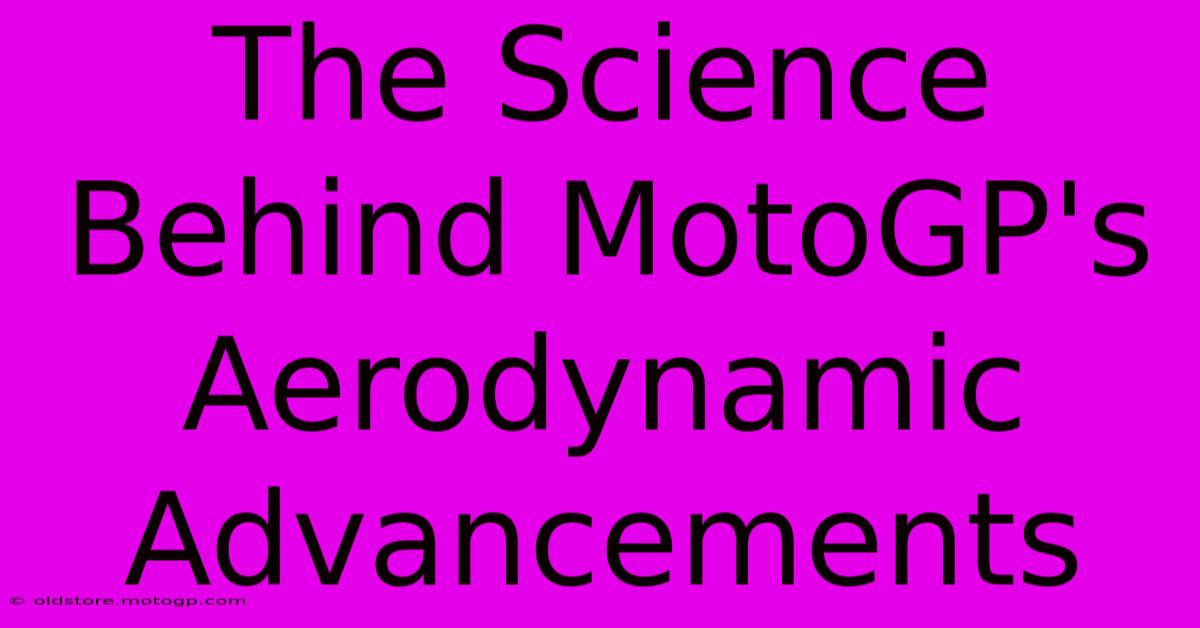The Science Behind MotoGP's Aerodynamic Advancements

Table of Contents
The Science Behind MotoGP's Aerodynamic Advancements
MotoGP, the pinnacle of motorcycle racing, is a relentless pursuit of speed and performance. While rider skill and engine power are crucial, a significant, often overlooked, factor contributing to lap times is aerodynamics. This article delves into the complex science behind the aerodynamic advancements constantly shaping MotoGP bikes, exploring how these innovations translate to faster lap times and improved rider control.
Understanding Aerodynamic Forces in MotoGP
MotoGP bikes, unlike their road-going counterparts, operate at incredibly high speeds, generating significant aerodynamic forces. These forces include:
- Drag: This resistive force opposes the bike's motion, slowing it down. Minimizing drag is crucial for achieving higher top speeds.
- Downforce: This force pushes the bike downwards, increasing grip and stability, particularly through corners. Generating sufficient downforce without excessive drag is a key engineering challenge.
- Lift: The opposite of downforce, lift pushes the bike upwards, reducing stability and grip. Engineers strive to minimize lift at all speeds.
Aerodynamic Innovations Shaping MotoGP
The quest for optimal aerodynamic performance drives constant innovation in MotoGP. Key advancements include:
1. Winglets and Aerodynamic Appendages:
These small wings or appendages, strategically positioned on the fairing, generate significant downforce. Their design is highly sophisticated, employing computational fluid dynamics (CFD) simulations to optimize their performance. The placement and angle of winglets are crucial; altering them even slightly can significantly impact downforce and drag. Careful design ensures maximum downforce with minimal drag penalty.
2. Fairing Design and Optimization:
The shape of the fairing plays a vital role in managing airflow around the bike. Sophisticated CFD modeling allows engineers to fine-tune the fairing's contours to minimize drag and optimize downforce. Streamlined fairings reduce air resistance, leading to higher top speeds. The fairing's design also significantly affects rider comfort and reduces wind blast at high speeds.
3. Underbody Aerodynamics:
The airflow under the bike is equally crucial. Designers focus on creating an effective undertray to manage airflow and minimize drag. An optimized undertray creates a low-pressure zone underneath, increasing downforce. This underbody aerodynamics work in conjunction with other elements for overall balance.
4. Computational Fluid Dynamics (CFD):
CFD plays a pivotal role in MotoGP aerodynamic development. This advanced simulation technique allows engineers to virtually test different aerodynamic designs, predicting their performance before physical prototyping. CFD saves time and resources by identifying optimal designs early in the development process. It allows teams to optimize every detail, even the smallest design changes impacting downforce and drag.
The Impact of Aerodynamic Advancements on Race Performance
The constant refinement of aerodynamic designs in MotoGP translates to tangible improvements in race performance:
- Increased Cornering Speeds: Enhanced downforce allows riders to take corners at significantly higher speeds, improving lap times.
- Improved Stability: Greater downforce provides increased stability, particularly in high-speed sections and during braking.
- Enhanced Braking Performance: Better stability enhances braking performance allowing for more aggressive braking maneuvers.
- Reduced Fatigue: Improved aerodynamics reduce rider fatigue from wind blast, allowing for better concentration throughout the race.
The Future of Aerodynamics in MotoGP
The relentless pursuit of aerodynamic perfection continues in MotoGP. Future advancements will likely involve:
- More sophisticated CFD modelling: This will lead to even more refined and efficient aerodynamic designs.
- Active aerodynamics: Systems that adjust aerodynamic elements in real-time based on speed and track conditions.
- Advanced materials: Lighter and stronger materials will enable the creation of even more efficient aerodynamic components.
In conclusion, the science behind MotoGP's aerodynamic advancements is a fascinating blend of engineering, physics, and computational modeling. The relentless pursuit of aerodynamic efficiency translates directly to faster lap times, improved rider control, and ultimately, more exciting races for fans worldwide. The ongoing innovations promise even more thrilling battles on the track in years to come.

Thank you for visiting our website wich cover about The Science Behind MotoGP's Aerodynamic Advancements. We hope the information provided has been useful to you. Feel free to contact us if you have any questions or need further assistance. See you next time and dont miss to bookmark.
Featured Posts
-
Austin Gp Sprint Race The Sound Of Speed
Feb 23, 2025
-
Circuit Of The Americas Parking Conquer The Chaos With Lot F
Feb 23, 2025
-
Moto Gps Defining Moments Tnt Sports
Feb 23, 2025
-
Unbelievable Finish See Who Conquered The Grand Prix
Feb 23, 2025
-
The Formula 1 Shuttle Your Private Jet On The Ground
Feb 23, 2025
